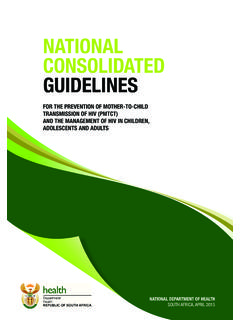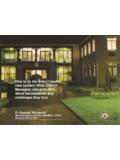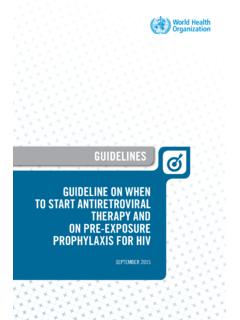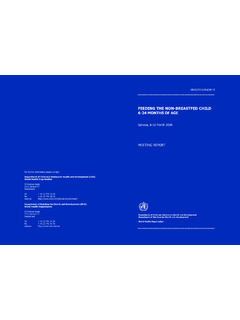Transcription of Infant Feeding in the context of HIV in South Africa
1 Infant Feeding in the context of HIV in South AfricaProduced by the Yezingane Network and UNICEF December 2010, updated July 2011 Questions and AnswersIf the mother is HIV-positive should she exclusively breastfeed? How can HIV transmission through breast milk be avoided?Exclusive breastfeeding means giving a baby no other food or drink not even water except breast milk. It does, however, allow the Infant to receive drops and syrups (vitamins, minerals and medicines) if needed. (WHO)What is the best way to feed a baby?1. A few examples of complimentary foods are raw fruits, vegetables, protein (meat, milk, cheese, beans) and carbohydrates (potatoes, rice, porridge).
2 23 Exclusive breastfeeding for the first six months is the most beneficial way to feed all babies; if the mother is HIV-negative she should ideally continue breastfeeding until the baby is two years old, or longer according to the mother s wishes, with complementary foods added from six months. If the mother is HIV-positive, breastfeeding should be accompanied by antiretroviral treatment for the mother or prophylaxis (daily nevirapine) for the baby. When HIV-positive mothers stop breastfeeding, they should do so gradually over a period of one month. From the age of six months breast milk alone is no longer sufficient to meet a baby s nutritional needs.
3 Age-appropriate, safe and nutritionally adequate complementary foods and liquids should, therefore, be given in addition to breast milk1. When the baby is between the ages of 6-8 months, complementary foods should initially be given 2-3 times a These guidelines are from the National Department of Health Clinical Guidelines for PMTCT (Prevention of Mother-to-Child Transmission) 2010ii and the National Department of Health Infant and Young Child Feeding breastfeeding contributes to building healthy babies and children, and ensures that babies do not get sick as it strengthens their immune system and protects them against death from illnesses such as diarrhoea and These benefits are true even in areas where HIV is a common problem, and even though breast milk carries HIV and can transmit HIV.
4 The section below explains why HIV positive mothers should Recent evidence shows that mothers who are HIV-positive should exclusively breastfeed because of the many health and survival benefits to babies, so long as the mother or baby receives antiretroviral treatment or prophylaxis. We now know that there is reduced risk of HIV transmission through breastfeeding if antiretroviral treatment or prophylaxis is used by either the mother or baby. Research has also shown that when HIV-positive mothers exclusively breastfeed rather than using mixed Feeding (which is a combination of breast milk and formula Feeding ); there is much less transmission of HIV.
5 Exclusively breastfed babies whose mothers are HIV-positive thrive and benefit, as do all babies, from the many nutritional benefits of breast milk. They are also at less risk than mixed-fed babies of developing and possibly dying from diarrhoea and evidence shows that if a mother or baby is on antiretroviral treatment or prophylaxis throughout the period of breastfeeding, the chances of HIV transmission to the baby through breastmilk is significantly reduced. The likelihood of HIV transmission increases when there are higher viral loads in the blood or breast milk, antiretroviral treatment or prophylaxis decreases the viral loads in the blood and breast milk.
6 This significantly reduces the likelihood of mother-to-child-transmission of a breastfeeding mother who is HIV-positive or her baby be on antiretroviral treatment?What is the South African Government s guidelines on HIV and breastfeeding?Note: In light of WHO 2009 recommendations and the South Africa context , there needs to be further clarity in policy/guidelines about when breastfeeding should be stopped for HIV-positive In order to significantly reduce the chances of HIV being transmitted to the baby, either the mother or the baby should be on antiretroviral treatment (for mother) or prophylaxis (for baby).
7 If a mother is already on lifelong antiretroviral treatment (ART) she must continue taking the treatment as normal throughout the breastfeeding period. In addition, the baby must receive antiretroviral prophylaxis daily for six weeks after birth. If the mother s CD4 count is above 350 she will probably not be on antiretroviral treatment (ART). She then has two options. Either: 1. She must go on to antiretroviral prophylaxis for as long as she breastfeeds, and for one week after breastfeeding stops. Or, 2. The baby must get antiretroviral prophylaxis throughout the breastfeeding period, and for one week after breastfeeding stops.
8 The second option (daily nevirapine prophylaxis for breastfeeding babies until one week after breastfeeding stops) is part of the current South African PMTCT 2010 the Government adopted a new strategy (as part of the revised PMTCT guidelines) which encourages exclusive breastfeeding for all HIV-exposed babies until six months old. The new guidelines state that: All babies with mothers who are HIV-positive must receive antiretroviral prophylaxis daily for six weeks after birth, and If the HIV-positive mother is not on lifelong antiretroviral treatment and the baby is breastfeeding, then the baby must be given antiretroviral prophylaxis (PMTCT regime Infant component daily nevirapine), throughout the breastfeeding period, up until one week after breastfeeding stops.
9 If the HIV-positive mother is definitely not breastfeeding and will never breastfeed then the daily antiretroviral prophylaxis (nevirapine) can be stopped six weeks after delivery All women who are HIV-negative, of unknown HIV status, and/or have HIV-positive infants should be advised to exclusively breastfeed their babies for the first six months of life and to continue breastfeeding with complimentary foods up to at least two years. This treatment is available, free of charge, from government clinics and are the benefits of exclusive breastfeeding for the BABY?
10 Iv ..and for the MOTHER?- what are the missed benefits?Not Exclusively Breastfeeding - what are the risks? 67 Breast milk contains important antibodies which strengthen the baby s immune system, leading to optimal growth, development and health. Breast milk reduces the chances of babies dying from common childhood illnesses such as diarrhoea or pneumonia, and leads to quicker recovery during illness. Exclusive breastfeeding protects the baby s stomach lining (intestinal mucosa) making it an effective barrier to infections. Breast milk is the best food for babies as it gives them all the nutrients they need and reduces the risk of malnutrition.













